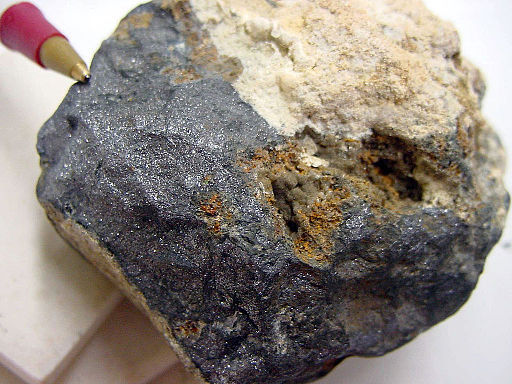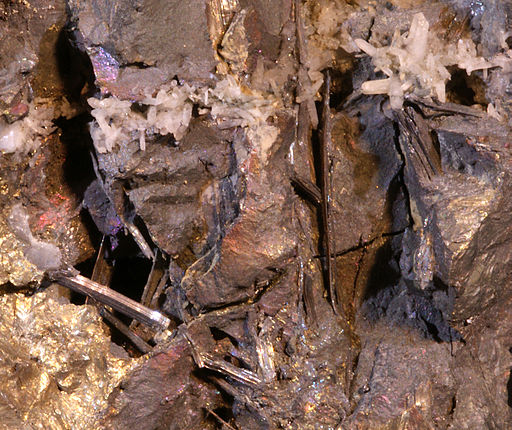Bismuth
Bismuth is a chemical element, number 83 on the periodic table. When it occurs naturally, it is a rather boring shiny grey metallic substance, which looks similar to Galena. When melted, however, and allowed to cool at different temperatures, it forms into unearthly crystalline formations in a range of rainbow colours.
Bismuth is often cast into different shapes – hearts, pyramids, ‘hoppers’, ‘geodes’ and other small decorative shapes are common.
Appearance
Naturally occurring Bismuth can occur in ores or as crystalline forms, typically in a grey-silver colour.
Bismuth has an unusual property when treated. When melted and cooled, it oxidises very quickly, which causes a thin Oxide layer on its surface. This oxide layer causes bright and unusual colours which give the crystals and amazing appearance.
Artificially grown Bismuth crystals also have a bizarre crystal formation, a stepped, spiral structure which looks unearthly.
Uses and History
Bismuth has an unusually low level of toxicity for a heavy metal, and has a few industrial uses.
In some cases, it is used as a non toxic replacement for Lead, used in Bismuth alloys.
It is often used in chemicals, medicines, and cosmetics – one popular brand you’ll probably have heard of is ‘Pepto-Bismol’, which takes a part of its name from Bismuth.
Locales
Bismuth occurs in a few countries around the world, both in its native elemental form and as an ore. The most important countries for Bismuth production are China and Vietnam, but there are many other occurrences.
Locales include Australia, Austria, Bolivia, Canada, China, France, Germany, Greece, Hungary, Italy, Japan, Kazakhstan, Mexico, Namibia, Russia, Spain, the UK, the USA, and Vietnam.
Mineralogy
Bismuth occurs primarily in ores – the most important of which are bismuthinite and bismite. There are naturally occurring crystals but they are few and far between.
The more common pieces with the fantastic colours have been heated and cooled to produce their colours and shapes.
Naturally occurring, Bismuth is a grey, white, silver metal.
Laboratory manufactured crystals can produce a range of colours, including violets, blue, green, yellow, gold, orange, and red. They will almost always be a mixed colour, as the colours are caused by cooling rates – typically the middle of the specimen will have a higher thermal mass.
Bismuth may be difficult to diagnose in its natural forms; a combination of specific gravity and hardness testing will help to narrow it down.
For treated crystals, which have been artificially shaped, diagnostics should be easy purely by eye and experience.
Photos of naturally occuring Bismuth ores
Photos of processed crystalline Bismuth
Hazards and Warnings
Bismuth is toxic, although one of the less toxic heavy metals. Most poisonings are by ingestion, via medicines, though. Please note, though – exposure can occur through the skin, by inhalation, or ingestion. Skin exposure to Bismuth crystals for a limited amount of time should not be too much of a concern; just make sure to wash your hands.
Almost all rocks, minerals (and, frankly, almost all other substances on earth) can produce toxic dust when cutting, which can cause serious respiratory conditions including silicosis.
When cutting or polishing rocks, minerals, shells, etc, all work should be done wet to minimise the dust, and a suitable respirator or extraction system should be used.
Translations
Arabic:
- البزموت
Hindi:
- विस्मुट
Portuguese:
- bismuto
Bengali:
Indonesian:
- bismut
Punjabi:
- ਬਿਸਮਥ
English:
- bismuth
Italian:
- bismuto
Russian:
- висмут
French:
Japanese:
- ビスマス
Spanish:
- bismuto
German:
- Wismut
Korean:
Thai:
- บิสมัท
Gujurati:
- બિસ્મથ
Mandarin and Traditional Chinese:
- 铋
- 鉍
Urdu:






